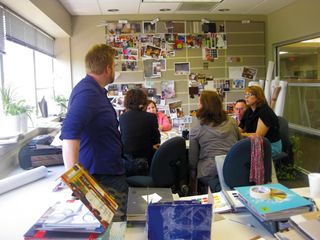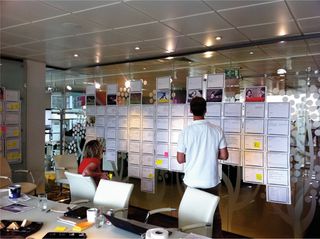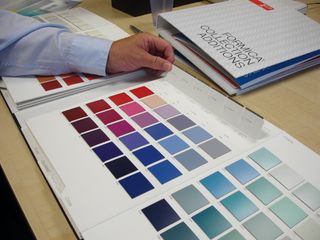7 ways to make user research work for you
How to collect objective insights using ethnographic research.

If you want to design innovative and engaging user interfaces, it's critical to understand how people behave. For example, how they order something, access specific information or look for help. So, in order to uncover key insights into the way people act when using a specific product or service, we use ethnographic research techniques.
Ethnographic research is an effective research method for gaining perspective on the way people think, behave and understand. It's qualitative not quantitative: we collect information by watching how someone interacts with an interface or does something, instead of asking them. It provides a greater insight into customers, which, in turn, helps us to make smarter, more informed design solutions.
This technique is a fantastic tool to have in the UX box of tricks, but it can sometimes be a challenge to remain objective. You can never be totally objective, but I have established seven key principles and techniques to help you take into account a more holistic approach to collecting the facts...
01. Keep the team varied

To achieve an impartial point of view, it's important to select research teams from a wide variety of disciplines from the designers to developers. For example, if we were investigating a mortgages website, it would be far more effective for some researchers to have extensive home-buying experience and others to have a limited view, rather than only having experts whose knowledge and assumptions may cloud the results.
As well as keeping the team mixed, at TH_NK we include client representatives in each research team to provide extra context and highlight when findings contradict existing assumptions. When we are conducting research, we split into pairs: this enables us to achieve a varied, more rounded interpretation of our findings.
02. Take personalities into account
When observing behaviour, it's really important to take into account people's personalities, because as a researcher you're making an interpreted judgment.
But it's also important to be mindful of subjects' character traits to understand the significance of answers or behaviour. If you ask an optimist and a pessimist to describe an identical experience you will get very different answers!

03. Build a good rapport
It's crucial to build a rapport with the person who is using your product or service. This helps them feel comfortable and willing to communicate unfiltered information. You want to know the good, the bad and the ugly, not just what they think you want to know, so being personable and chatty is essential from the word go. Some people are happy to chat before they get started, whereas others need to know the specifics of the task in hand.
To build rapport, I start by introducing who I am and what I do at a basic level. At this stage, I tell them to treat me like a novice, and ask questions that highlight that I am not an expert. This encourages subjects to describe things as they would in everyday life and reinforces that I'm not testing them. While theoretically you should avoid leading questions, I have found that in reality you sometimes need to ask them in order to focus the conversation.
Usually people want to provide you with useful information - and I find that how I respond influences what a subject emphasises. Although I record the audio of every session, I also make a bubble map during, making the person feel that what they are saying is worthwhile. This also enables me to return to key points at natural points within the flow of conversations.
04. Interpret the responses

A subject's responses are open to interpretation. Sometimes people can find it hard to find the words to describe what they mean in what are essentially unprepared conversations. Often I find the best thing to do is to ask them to demonstrate what they mean when they are struggling to be descriptive.
If something can't be observed I find asking the same question in different ways during conversation helps get to the bottom of what a subject means, drawing out the facts over time. I use a well-known technique - the 'five whys' - like a child, repeatedly asking 'why?' to glean understanding the world.
05. Observe the scene
As well as observing a subject and listening to what they say, it's just as important to note their environment; to watch how someone works and their environmental factors provides clues to any usability issues.
Video is best for recording the subject within their context. Unlike audio, it records the full scene, in particular body language, and provides clues to how they actually feel.
06. Avoid fixating on solutions
Whether consciously or subconsciously, researchers always have the purpose of the research and sometimes solutions or biases in their thoughts.
We know we shouldn't create solutions during the research, but it's unavoidable. The key is to not let them stick in your mind. Human minds look for things that reinforce our own thoughts and opinions. Therefore, I find it best to get thoughts out of my mind and on to paper by creating mind maps of what I see and hear. I code them with topic categories which help me to create connections between observations.
The next day I reflect on what I've mapped out as I often spot different things when I'm in a different frame of mind.
07. Draw objective insights

I have found the best way to recognise objective insights is for the research team to create an insight wall made up of sticky notes grouped into themes. The full research team, including the client, shares research and thoughts, discussing them to identify patterns of behaviour. These patterns, often pulled from seemingly unrelated actions, can map the way and reveal potentially innovative solutions.
Behavioural insights are harder to uncover than usability ones. With this in mind, we draw on the collective intuition of the team to determine these. We make multiple passes through the research and consider whether influences such as personality, culture, or context are reflected in the groupings.
Illustration: Sam Williams
This article first appeared in issue 232 of net magazine.
Learn how to conduct your own qualitative user research at Generate London on 20-22 September as well as how to master user experience strategy, build scalable responsive components, create interactive web animations, design adaptive interfaces, find a good balance between creativity and productivity, and much more. Reserve your spot now!

Thank you for reading 5 articles this month* Join now for unlimited access
Enjoy your first month for just £1 / $1 / €1
*Read 5 free articles per month without a subscription

Join now for unlimited access
Try first month for just £1 / $1 / €1
Get the Creative Bloq Newsletter
Daily design news, reviews, how-tos and more, as picked by the editors.
